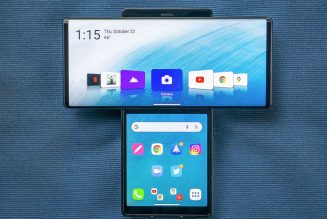I’ve used more Acer laptops than most people on the planet. I’ve tested Swifts, Aspires, Travelmates, Spins, ConceptDs, and Predators. More often than not, my assessment is “not bad, but there’s better.” For much of my time covering this company, I’ve associated it with excellent value — and not too much else.
To some extent, Acer seems to share this view. Verge editor-in-chief Nilay Patel and I spoke to Acer CEO Jason Chen and Acer Pan-America President Gregg Prendergast ahead of the company’s global press conference on May 27th, and Patel asked the two to characterize the “Acer customer” — that is, the type of person who seeks out Acer laptops to buy. Chen’s answer implied that the company is still looking for it. “We are building up new business engines,” he says. “We are moving Acer to be a lifestyle brand, to focus on a specific target audience, to offer more products we’ve never done before.”
Those sorts of ambitions are evident among the company’s recent releases, as well as its long list of announcements from the press conference. The slate includes new gaming laptops, creator workstations, monitors, desktops, Chromebooks, Swifts, Travelmates, and more. But broadly, it looks to me like Acer throwing a lot of things at the wall to see what sticks. And that might be the defining characteristic it needs.
:no_upscale()/cdn.vox-cdn.com/uploads/chorus_asset/file/22542169/acastro_210526_4606_0001.jpg)
One of the angles Acer’s trying: sustainability. The company announced that it’s joined the RE100 initiative and has pledged to achieve 100 percent renewable energy use by the year 2035 — the same deadline President Biden has set for the US to eliminate carbon pollution from the power sector. Alongside, the company announced the Aspire Vero — its first “sustainability-focused product” — which has keycaps that are 50 percent post-consumer recycled (PCR) plastic, and other surfaces (including the top and bottom covers, bezels, and operating surface) that are 30 percent PCR plastic.
Acer isn’t the first company to launch a product like this; HP’s Elite Dragonfly line, for example, also incorporates some PCR plastics in its speaker box and bezels. But the Vero is the first laptop we’ve seen that’s specifically modeled around sustainability. Acer is touting other features as well, including a box made from recycled paper pulp, a laptop bag made with recycled plastic, graphics printed in soy ink, and inverted text on the R and E keys to emphasize “reduce, reuse, and recycle.” (I asked if Acer has done anything to increase the Vero’s durability — given that e-waste is a cardinal sin of electronics manufacturing from a sustainability standpoint — and Chen said it will have Acer’s usual warranty and that he expects it to have the same lifespan as any “normal” PC.)
But Chen views the Vero not only as a step toward its sustainability pledge, but also as a milestone for the market, with Acer’s name attached. “This is the first product for the industry,” he says. “Somebody had to be the first one.” And while Chen is open to the possibility of putting these materials in laptops across Acer’s lines, that’s a longer-term project. The Vero will likely start as a regional, online launch. “Hopefully this kind of material usage will be expanded,” Chen says. But “this is the first product, the first trial.”
:no_upscale()/cdn.vox-cdn.com/uploads/chorus_asset/file/22542313/acastro_210526_4606_0002.jpg)
That wait-and-see sentiment pervaded much of our conversation. I asked whether Chen views Acer’s Swift 3X, released earlier this year as one of very few laptops to include Intel’s puzzling entry-level GPU, as a success. “To be seen,” he replied. “We are excited to see more options for graphics for the industry, and we want to try to include them in our product lines and offer to our customers to see how it goes.” Chen added, “We will see.”
The company is releasing another unique gaming product this time around in the Predator Triton 500 SE, its first gaming laptop with a 16:10 display. 16:10 gaming laptops have picked up steam this year among premium lines, but they’re still highly unusual. All modern games support the 16:9 aspect ratio, but not all support 16:10, and quality varies among those that do. So a 16:10 Triton 500 isn’t just a taller product; it nods to a shift in the philosophy of the Triton line. It’s a Triton that’s meant to be equally useful for work and for play.
But is the Predator family actually moving in that direction? Will we see more 16:10 in the future? Again, Chen wasn’t sure. “We don’t know yet,” he admitted. “We’d like to try the market and see how it goes.”
“Seeing how it goes” will involve a patchwork of metrics and stakeholders. Some design choices are influenced by retailers, and Best Buy, in particular, with which Acer has co-developed some products in the past. “They get to have a lot of influence on the aspect ratio of the screen,” says Prendergast. “It’s worth it, because they’re half the gaming market in the US.”
That’s a strong statement about Acer’s priorities — it’s hard to imagine Apple bending the MacBook Air to Best Buy’s whims. But Acer isn’t targeting the MacBook crowd — certainly not in the gaming sphere. “The top-selling products at Best Buy are not the premium assortment,” Prendergast says. “They’re products like Nitro that are $699, $799. That’s where the real velocity is.” And those co-developed products, Prendergast adds, typically sell out through Acer and Microsoft’s online stores once Best Buy releases its exclusive after six months or so. “It’s worth doing for us, given the scale they have.”
The company also watches web searches, reads reviews, listens to hotline calls for feature keywords using AI, and relays information up the chain. And it pays close attention, Prendergast adds, to “how customers are voting with their wallet.”
:no_upscale()/cdn.vox-cdn.com/uploads/chorus_asset/file/22542328/ConceptD_5_Pro_CN516_72P_Lifestyle_01.jpg)
Of today’s flashiest new releases, there’s one that Chen seems to be behind in full force: SpatialLabs. SpatialLabs is a proprietary system that allows Acer’s ConceptD laptops to present content in stereoscopic 3D without any need for glasses, using a combination of eye tracking, real-time rendering technology, and a lenticular display. I’ve tried SpatialLabs myself, and things really do have depth and pop out at you.
The target audience for SpatialLabs is limited. Only one person can use it at a time, you can’t have a mask on, and you can’t be in strong light. You also need access to a powerful system — my demo unit included an eight-core Core i7-10875H and an Nvidia Quadro RTX 3000, and Acer’s engineer told me he wouldn’t advise running SpatialLabs on anything weaker. Most importantly, as cool as SpatialLabs looks, the pragmatic use case is fairly specific; many artists and designers who work with 3D are still creating for viewers who don’t have SpatialLabs and will be looking at a 2D image, so the technology would mostly help people who are developing for VR or 3D TV.
Chen agrees that the initial user base will be small. But here, he’s actually confident that the audience will grow. “We think the technology’s getting mature to the level it’s now good for developers,” he says. “Gradually will be next year, or the year after next to the general public. We look forward to it.” While the SpatialLabs is debuting on ConceptD laptops, Prendergast predicts that we’ll see it on future Acer all-in-ones as well.
Would the company license the tech for more widespread adoption? “We are keeping any possibility open,” Chen says.
:no_upscale()/cdn.vox-cdn.com/uploads/chorus_asset/file/8521419/akrales_170508_1666_0024.0.jpg)
Even ephemeral innovations can help put companies on the map. Chen still views Acer’s Predator 21X — a 19-pound, $9,000 gaming rig with two GPUs, five fans, and a curved 21-inch screen — as a success story, despite the fact that it only made and sold around 300 units. “Do we make a lot of money on our 21X? The answer is no,” Chen says. “What do we get? We get a ‘wow’ impact.” (Chen did confirm that Acer has no plans to refresh the 21X.)
“They’re innovation, they’re fun,” Prendergast added. “We’re not trying to sell thousands of units, but it’s good for the brand.”
I didn’t get a clear image from Chen of what Acer’s transformation into a “lifestyle brand” will look like, apart from a callout to the company’s line of energy drinks. What I do sense is that the Acer of the future doesn’t look much like Apple, arguably the quintessential lifestyle brand of the US tech space. It won’t be a company with a strong, unique vision in a particular sphere, or one with a passionate and deep-pocketed fan base that lives for its products. Acer’s vision is looser and wider.
It’s possible that in 10 years, Acer will be the company that pioneered 3D laptop screens. It’s possible it’ll be the go-to company for versatile and stylish gaming laptops, the way Razer was once upon a time. It’s possible it’ll be the company leading the way in green manufacturing — a position laptop manufacturers around the world certainly covet.
It may also just be known as the company that’s willing to try anything. And Chen seems to agree that’s not a bad sort of company to be.









